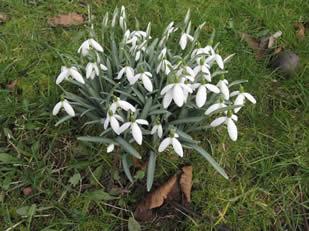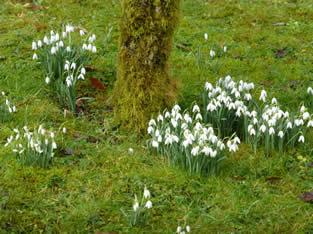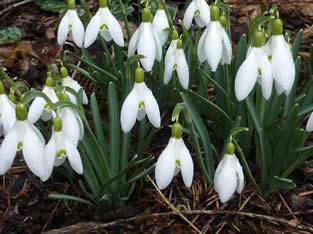Latin name: Galanthus nivalis
by Vancouver Island Master Gardeners Association
The snowdrop, renowned from children's poems and songs, are among the earliest harbingers of spring.
In Milner Gardens & Woodland, snowdrops are found under the orchard trees as early as late January/early February. Because the bulbs multiply freely given moist, semi-shade, humus-rich conditions, planting a single bulb will result in a spectacular clump of flowers in a few years. Clumps of bulbs can readily be divided and transplanted into new areas of the garden. Some cultivars self-seed. Plants are deer-resistant. Because leaves die back after the plants have bloomed, they are good for lawn planting, creating a pleasant spring feature, while not being a nuisance when mowing becomes necessary.
There are approximately 20 species and many recognized cultivars.
Generally, flowers are white with green markings on the tip of the inner tepals. Some cultivars have double flowers and some cultivars are fragrant.
The genus of bulbous perennials, belonging to the family Amaryllidaceae, is native from Europe to West Asia.



Photos courtesy of: Dorothee Kieser
Attribute | Description |
|---|---|
Form: | Perennial bulb. |
Foliage: | Basal leaves arising from the bulb, bluish-green, lance-shaped. |
Height/Width: | Dependant on cultivar, 7-15 cm (2-3/4-6 in) high. |
Hardiness Zone: | Hardy, some cultivars are hardy to Zone 4. |
Exposure: | Partial shade/open woodlands. |
Flower colour: | White with green inverted V-shaped markings. |
Leaf colour: | Grayish blue-green. |
Flower time: | In Zone 8, as early as February/March. |
Preferred soil and Watering: | Lightly moist, humus-rich, well-drained woodland soil. |
Other: | Galanthus is deer-resistant. Its name designated by Linnaeus, arises from Greek: Galanthus means "Milk flower" and nivalis "of the snow". All parts of the plant if ingested cause mild stomach upsets. Contact with bulbs can cause skin irriation. The plant contains galanthamine which, while not a cure, can be helpful in the treatment of Alzheimer's disease. |

